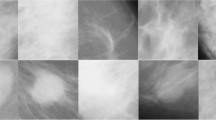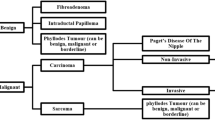Abstract—Early detection of breast abnormalities through mammography screening and proper treatment reduces mortality and increases women’s life expectancy. Currently, methods and algorithms for computer diagnostic systems based on deep neural networks are being actively developed. Such systems combine selection, feature calculation, and classification, thereby directly creating a decision-making function. In this paper, a method for classifying breast pathologies according to the Breast Imaging Reporting and Data System (BI-RADS) based on deep learning is proposed. Experimental results are presented using two open databases of digital mammography and evaluated using various performance criteria.

Similar content being viewed by others
REFERENCES
F. Bray, J. Ferlay, I. Soerjomataram, R. Siegel, L. Torre, and A. Jemal, “Global cancer statistics 2018: Globocan estimates of incidence and mortality worldwide for 36 cancers in 185 countries,” CA: A Cancer J. for Clinicians 68, 394–424 (2018).
Methodical Recommendations about Use of the BI-RADS System at Mammography Inspection, Ed. by A. Yu. Vasil’ev (Moscow, 2017) [in Russian].
C. J. D’Orsi, E. A. Sickles, E. B. Mendelson, E. A. Morris, et al., ACR BI-RADS Atlas, Breast Imaging Reporting and Data System, 5th Ed. (American College of Radiology, Reston VA, 2013), pp. 1–79.
“American College of Radiology. ACR Breast Imaging Reporting and Data System (BI-RADS) Website,” http://www.acr.org.
J. Bozek, M. Mustra, K. Delac, and M. Grgic, “A survey of image processing algorithms in digital mammography,” Recent Advances in Multimedia Signal Processing and Communications, 631–657 (2009).
A. D. Trister, D. Buist, and C. Lee, “Will machine learning tip the balance in breast cancer screening?” JAMA Oncology 3 (11), 1463–1464 (2017).
L. M. Mina and N. A. M. Isa. “A review of computer-aided detection and diagnosis of breast cancer in digital mammography,” J. Medical Sci. 15 (3), 110 (2015),
M. S. Salama, A. S. Eltrass, and H. M. Elkamchouchi, “An improved approach for computeraided diagnosis of breast cancer in digital mammography,” in Proc. IEEE Int. Symp. on Medical Measurements and Applications,Rome, Italy, June 11—13, 2018 (IEEE, New York, 2018), pp. 1–5.
K. Doi, “Computer-aided diagnosis in medical imaging: historical review, current status and future potential,” Comput. Med. Imaging Graph. 31, 198–211 (2017).
D. Halalli and A. Makandar, Computer Aided Diagnosis—Medical Image Analysis Techniques, Breast Imaging, Ed. by C. M. Kuzmiak (IntechOpen,(2018).
Y. Goodfellow and A. Bengio, Courville. Deep Learning (MIT Press, 2016).
K. Simonyan and F. Zisserman, “Very deep convolutional networks for large-scale image recognition” arXiv: 1409.1556, (2014).
C. Szegedy, W. Liu, Y. Jia, P. Sermanet, S. Reed, D. Anguelov, D. Erhan, V. Vanhoucke, and A. Rabinovich, “Going deeper with convolutions,” IEEE Computer Vision and Pattern Recogn. (2015). http://arxiv.org/abs/1409.4842.
K. He, X. Zhang, S. Ren, and J. Sun, “Deep residual learning for image recognition,” Tech. Report (2015). http://arxiv.org/abs/1512.03385.
L. Zou, S. Yu, T. Meng, Z. Zhang, X. Liang, and Y. Xie, “A Technical Review of Convolutional Neural Network-Based Mammographic Breast Cancer Diagnosis,” Comput. Math. Meth. Med. 219, 6509357 (2019).
H. Wang, J. Feng, Z. Zhang, et al., “Breast mass classification via deeply integrating the contextual information from multi-view data,” Pattern Recogn. 80, 42–52 (2018).
N. Dhungel, G. Carneiro, and A. P. Bradley, “A deep learning approach for the analysis of masses in mammograms with minimal user intervention,” Medical Image Analysis 37, 114–128 (2017).
Saeed Seyyedi, Margaret J. Wong, Debra M. Ikeda, and Curtis P. Langlotz, “SCREENet: A Multi-View Deep Convolutional Neural Network for Classification of High-resolution Synthetic Mammographic Screening Scans,” arXiv:2009.08563v3, (2020).
A. Ruchai, V. Kober, K. Dorofeev, V. Karnaukhov, and M. Mozerov, “Classification of breast abnormalities using a deep convolutional neural network and transfer learning,” J. Commun. Technol. Electron. 66, 778–783 (2021).
K. He, X. Zhang, S. Ren, and J. Sun, “Deep residual learning for image recognition,” arXiv: 1512.03385v12015.
J. Suckling et al., “The mammographic image analysis society digital mammogram database,” Mammographic Image Analysis Society (MIAS) database v1.21 [Dataset] (2015). https://www.repository.cam. ac.uk/handle/1810/250394.
M. Sorkhei, Y. Liu, H. Azizpour, et al., “CSAW-M: An ordinal classification dataset for benchmarking mammographic masking of cancer,” arXiv:2112.01330v1, (2021).
J. Diaz-Escobar, V. Kober, V. Karnaukhov, and M. Mozerov, “Recognition of breast abnormalities using phase features,” J. Commun. Technol. Electron. 65, 1476–1483 (2020).
V. Kober, “Robust and efficient algorithm of image enhancement,” IEEE Trans. Consumer Electron. 52, 655–659 (2006).
V. Kober, M. Mozerov, and J. Alvarez-Borrego, “Nonlinear filters with spatially-connected neighborhoods,” Opt. Eng. 40, 971–983 (2001).
I. Moreno, V. Kober, V. Lashin, J. Campos, L. Yaroslavsky, and M. Yzuel, “Color pattern recognition with circular component whitening,” Opt. Lett. 21, 498–500 (1996).
M. Abdar and V. Makarenkov, “Cwv-bann-svm ensemble learning classifier for an accurate diagnosis of breast cancer,” Measurement 146, 557–570 (2019).
D. P. Kingma and J. Ba, “Adam: A method for stochastic optimization,” arXiv:, 6980 (2014).
J. Deng, W. Dong, R. Socher, et al., “Imagenet: A large-scale hierarchical image database,” in IEEE Conf. on Computer Vision and Pattern Recognition (CVPR 2009), Miami, Florida, USA, June 20–25, 2009.
S. Dutta and E. Gros, “Evaluation of the impact of deep learning architectural components selection and dataset size on a medical imaging task,” Medical Imaging: Imaging Informatics for Healthcare, Research, and Applications (Presented at SPIE Medical Imaging: February 15, 2018).
Funding
The work was supported by the Russian Science Foundation, project no. 22-19-20071.
Author information
Authors and Affiliations
Corresponding authors
Ethics declarations
The authors declare that they have no conflicts of interest.
Additional information
Translated by S. Avodkova
Rights and permissions
About this article
Cite this article
Gomina, P.S., Kober, V.I., Karnaukhov, V.N. et al. Classification of Breast Abnormalities Using Deep Learning. J. Commun. Technol. Electron. 67, 1552–1556 (2022). https://doi.org/10.1134/S1064226922120051
Received:
Revised:
Accepted:
Published:
Issue Date:
DOI: https://doi.org/10.1134/S1064226922120051




